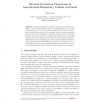Free Online Productivity Tools
i2Speak
i2Symbol
i2OCR
iTex2Img
iWeb2Print
iWeb2Shot
i2Type
iPdf2Split
iPdf2Merge
i2Bopomofo
i2Arabic
i2Style
i2Image
i2PDF
iLatex2Rtf
Sci2ools
ACRI
2006
Springer
2006
Springer
Directed Percolation Phenomena in Asynchronous Elementary Cellular Automata
Cellular automata are discrete dynamical systems that are widely used to model natural systems. Classically they are run with perfect synchrony ; i.e., the local rule is applied to each cell at each time step. A possible modification of the updating scheme consists in applying the rule with a fixed probability, called the synchrony rate. It has been shown in a previous work that varying the synchrony rate continuously could produce a discontinuity in the behaviour of the cellular automaton. This works aims at investigating the nature of this change of behaviour using intensive numerical simulations. We apply a two-step protocol to show that the phenomenon is a phase transition whose critical exponents are in good agreement with the predicted values of directed percolation.
| Added | 13 Jun 2010 |
| Updated | 13 Jun 2010 |
| Type | Conference |
| Year | 2006 |
| Where | ACRI |
| Authors | Nazim Fatès |
Comments (0)

